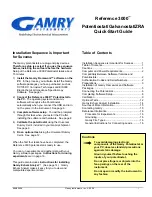
Technical Manual
Issue: A
Revision: 1
Date:21/11/16
Ref:100246
15
Cut a hole Ø28mm (1
1
/
8
ins) at the selected location and offer up the stub.
DO NOT attempt to weld
the stub to the stack with the probe attached to the stub, as the heat generated (and the
electric arc) will severely damage the probe and electronics.
Ensure the stub remains at 90
0
to
the stack, but
DO NOT weld when the collector is on line, as the weld pool may super-cool and
cracking may result.
Paint the stub with a suitable corrosion resistant paint, prior to mounting the
Energy Tech 301.
If the stack wall is thin gauge and will not weld easily or will not bear the weight of the probe, follow
the method below.
Thin-Walled Stacks
Manufacture a stub as described above. Prepare the mounting plate shown in Figure 5. Cut a hole
Ø28mm (1
1
/
8
ins) at the centre and drill for large pop rivets or self tapping screws. Bend the plate to
the curvature of the stack and weld the stub to the plate as outlined above.
DO NOT attempt to weld
the stub to the plate with the probe attached to the stub as the heat generated (and the electric
arc) will severely damage the probe and electronics.
Drill a hole Ø28mm (1
1
/
8
ins) in the stack. Offer up the plate and drill the securing holes
. It is
important to make the plate as large as possible to improve its load bearing capabilities.
Before securing the plate to the stack, coat its underside with a silicon sealer to ensure that the plate
does not allow any leakage. Paint the stub and mounting plate with a suitable corrosion resistant
paint.
If the probe is to be installed on a non-metallic duct, it will be necessary to install an
electrostatic (Faraday) shield around the area of the duct where the probe resides. The shield
should be of copper and connected to the enclosure by means of the earth plug at the front of
the enclosure and then on to ground. The shield will ensure that the probe does not detect
any stray electrical fields.
Figure 5: Mounting Plate for Thin-Walled
Stacks









































